 This receiver includes the features and functions of the TX-RZ800 (new design, Dolby Atmos, DTS: X), and also differs in some additional changes in the architecture. See what other Onkyo TX-RZ920 specs I noted in this Onkyo TX-RZ920 receiver.
This receiver includes the features and functions of the TX-RZ800 (new design, Dolby Atmos, DTS: X), and also differs in some additional changes in the architecture. See what other Onkyo TX-RZ920 specs I noted in this Onkyo TX-RZ920 receiver.
Onkyo TX-RZ920 review
Features
The model delivers power of 200 watts per channel (6 ohms). The receiver has passed THX certification and has the appropriate sound modes, along with traditional proprietary digital processing modes. It is possible to play "clear" sound in non-processing mode - Pure Audio. There is a Music Optimizer algorithm, enhanced bass mode and optimized bass mode - PM Bass. Like all Onkyo receivers, the TX-RZ920 has an extended set of interfaces. It has Wi-Fi, Bluetooth, DLNA technology and the long-awaited new AirPlay.
Design and build
The AV receiver received a new sleek design. The center of its aluminum facade is occupied by a display, under which there is a lid that hides the controls. The device uses a manually wound toroidal transformer, audiophile capacitors and high-current discrete amplifiers, which allow reaching the lower limit of the frequency response of 5 Hz. The AV receiver is equipped with a 32-bit DSP, supports Dolby Atmos up to 5.1.2-channel configuration, as well as the DTS: X format, which allows the use of additional ceiling speakers. Each Onkyo TX-RZ920 channel has an AK4458 DAC (32 bit / 384 kHz), and VLSC technology is used to eliminate noise caused by clock pulses.

Connectivity
The model has wide switching capabilities. Rear panel inputs: 7 HDMI ports (with 4K support), MM phono input, 2 coaxial / 3 optical, USB, Ethernet port, etc. Outputs: 2 x HDMI (one for zone 2), 7.2-channel (RCA) ), two RCA for additional zones and others. There are 11 pairs of screw terminals, two of which can be used for zones 2 and 3. You can control the receiver through the remote control or application for devices with Android and iOS.
Setup
This “smart” receiver is able to calibrate the sound in accordance with the user's preferences and the characteristics of the room where the speaker is installed (software product: AccuEQ).
Pros and Cons
Pros
- It produces a deep spatial sound, but the pitch itself is light and natural
- Cinema fans will like the soundness of the sound, and music lovers will appreciate the ability to customize the sound in accordance with their own preferences
Cons
- I wish the design was a bit more thoughtful
Common features
Product
Model
Brand
Reviews
Amplifier
Channels
Stereo power (RMS), W/Ohm
Output impedance, Ohm
Frequency response
THD in stereo, %
Audio features
Digital to analog converter (DAC)
Bi-amping
Pure direct (straight)
Auto speaker calibration
Speaker A/B switching
Other audio features
Connectivity
Wi-Fi
USB
Bluetooth
Ethernet (RJ45)
DLNA
MHL
Streaming services
Apple Music (AirPlay)
Amazon Music
Spotify
Other streaming services
Extensive connection
HDMI input/output
HDMI ARC (Audio Return Channel)
HDMI eARC (Enhanced Audio Return Channel)
HDMI CEC
Digital content protection (HDCP)
Subwoofer output (LFE)
Headphone output
Optical digital input
Coaxial digital input
Composite input
Component input/output
Phono (MM) input
Front panel connectors
Multi channel preamp output
Video features
HDR (High Dynamic Range)
4K signal pass-through
8K signal pass-through
HDMI signal pass-through
3D signal pass-through
HDMI pass-through in standby mode
Video conversion
Analog to HDMI scaling
HDMI to HDMI scaling
Dolby Vision
Other video features
Additional features
Voice control
App control
Display
Tuner
Sleep timer
Auto power off
ECO mode
Graphical user interface (GUI)
Setup assistant
Firmware update
Other additional features
Multi-room
Multi-room zones
Zone audio output
Zone HDMI output
Multi-room control
RS-232
Remote control input/output (IR)
DC trigger output (12V)
Multichannel surround
Dolby Atmos
Dolby TrueHD
Dolby Surround
Dolby (other)
DTS:X
DTS HD Master
DTS Virtual:X
DTS Neural:X
DTS (other)
Auro-3D
IMAX Enhanced
Multichannel stereo
Audio file formats
MP3
WMA
AAC
WAV
FLAC
ALAC
Other audio file formats
Power
Operational power consumption, W
Standby consumption, W
Removable power cord
User manual
Manual
Dimensions
Size W x H x D, cm/inches
Weight, kg/lbs
Other
Release year


